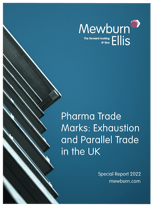
Parallel importing, the practice where third parties import branded goods already put on sale by the rights holder into a new country, has been a hot topic in the EU for years – and it’s particularly significant for pharmaceutical brand owners.
Since the EU guarantees freedom of movement on the one hand but has no harmonised healthcare concept or pricing structure on the other, it’s created a landscape that’s predestined for pharmaceutical parallel imports.
Brand owners – but especially pharmaceutical brand owners – should be aware of when they can object to parallel imports. This will help them take adequate measures to protect their rights and their brands from possible infringement.
The basics – what is a parallel import?
Under Article 15 of the European Union trade mark regulation (EUTMR), brand owners can’t prohibit the use of a trade mark in relation to goods which they have put on the market in the European Economic Area (EEA), or which have been put on the market with their consent. Simply put, this means that once a brand owner has sold goods that are branded with their trade mark in the EEA, they can (with some exceptions) be resold by third parties. This is called “exhaustion”.
Trademarked goods that are purchased in one EEA country and then sold in another country are called “parallel imports” – they have been imported often without the original brand owners’ permission parallel to the brand owners’ own goods. However, since these goods have been legally imported into an EEA country, the brand owner is generally prohibited from acting against the importer.
Parallel imports – impact for pharmaceutical brand owners
Pharmaceuticals often need to fulfil country-specific requirements to be able to be marketed in a specific country. Regulations require, for example, that importers include a country-specific warning label or a leaflet in the local language; consumers in Finland can’t read packaging or warning labels in German. A brand owner selling their goods on multiple national markets would simply package the goods in country specific packaging with a country specific patient information leaflet.
Parallel importers don’t generally have the same luxury – when strictly viewed under the law, the EUTMR doesn’t specifically permit parallel importers to change the packaging of the goods that they’ve imported.
However, to meet the needs of the pharmaceutical industry and ensure free trade across the European Economic Community (EEC), the Court of Justice of the European Union (CJEU) developed criteria under which relabelling or repackaging of pharmaceuticals is permissible.
In the Bristol-Myers Squibb judgement (C-427/93, C-429/93 and C-436/93 from 11 July 1996), the CJEU provided guidance on when a repackaging, relabelling, or rebranding was permissible. They decided that this was the case when:
- It was necessary to market the product.
- The repackaging, relabelling, or rebranding has no impact on the original condition of the product.
- The new packaging identifies the name of the importer and the manufacturer.
- The presentation of the repackaged product does not damage the reputation of the trade mark.
- The importer notifies the trade mark owner before the repackaged product is put on sale and provides a sample if requested.
Over the years, the CJEU has elaborated on and refined these criteria.
In several decisions, the CJEU has examined and expounded on when repackaging of pharmaceuticals is “necessary”. While it is ultimately for the national courts to examine if these requirements are met, the CJEU has provided guidance in several decisions.
According to the CJEU, repackaging may be necessary if the rules or practices in the importing Member State would prevent the product in question from being marketed in that Stated under its trade mark in the exporting Member State (CJEU, judgement from 12 October 1999, Case C-379/97, Parmacia & Upjohn SA v. Paranova A/S, paragraph 43). Where insurance rules make reimbursement of medical expenses dependant on certain packaging or where there are well-established prescription practices that are based, inter alia, on standard size recommendations, repackaging can also be necessary (CJEU, judgement from 23 April 2002, Case C-143/00, Boehringer Ingelheim KG and others v. Swingward Ltd. and others, paragraph 47).
The CJEU has clearly said that repackaging isn’t necessary if it’s solely to secure a commercial advantage (CJEU, judgement from 12 October 1999, Case C-379/97, Parmacia & Upjohn SA v. Paranova A/S, paragraph 44).
The CJEU has also addressed the question of the parallel import of generic medicinal products. The CJEU decided under what circumstances brand owners can take action against the parallel import of generic medicinal products that have been repackaged in packaging affixed with the corresponding trade mark of the reference medicinal product. In order for parallel imports of these goods to be permissible, the must be identical in all respects and fulfil the requirements set forth in the Bristol-Myers Squibb decision (CJEU, judgement from 17 November 2022, cases C-253/20 and C-254/20, Impexeco NV v. Novartis AG and PI Pharma NV v Novartis AG, paragraph 74).
Preventing unlawful parallel imports
Repackaging, rebranding, and relabelling that doesn’t follow these guidelines isn’t permissible, and brand owners can take measures to stop it. These can range from applications to action with customs authorities in some EU member states, to suing for infringement before the national courts.
In our Special Report "Pharma Trade Marks: Exhausting and Parallel Trade in the UK", Partner Jan Rether provided guidance on preventing unlawful parallel imports:
“Filing an Application for Action (AFA) with national Customs Authorities in EU Member States may be considered as an accompanying measure to enforce trade mark rights against illegal imports into the EU. However, it has to be noted that non-exhausted original goods are not covered by the scope of application of the EU Regulation No. 608/2013. Hence, a “Union application” on the basis of this regulation will not be helpful in this context. Rather, where available, an AFA has to be filed on the basis of national law in the respective EU Member State. In Germany, it is held that an AFA on the basis of Sec. 146 German Trade Mark Act (MarkenG) does cover such non-exhausted original goods. The AFA itself should then include detailed information on the trade mark owner’s marketing strategy which facilitates the Customs’ task of identifying such “obviously” infringing goods. Relevant and helpful information includes indications on routes of transport, exporting country, customs value, authorized importers and/or notorious illegal importers. Securing the distribution system by a coding system usually also proves to be very helpful.”
Key points for pharmaceutical trade mark owners
Pharmaceutical manufacturers should ensure that they have adequate trade mark protection for their products.
Once protection has been established, pharmaceutical brand owners should adopt a two-pronged approach. When approached by a parallel importer, they should seize the opportunity to request a sample to ensure that repackaging or relabelling is necessary and otherwise fulfils the above criteria.
Additionally, they should keep an eye on the market for parallel imports that don’t meet the above criteria and consider if national applications for action with customs authorities make sense.
Our dedicated team of trade mark experts at Mewburn Ellis can advise on all these aspects, from establishing protection to pursuing possible infringement claims and filing applications for action. Through our office in Munich, Germany, our attorneys are able to offer a full range of trade mark services before the EU and German trade mark offices and the German courts.
A detailed analysis of the current law and practice on exhaustion and parallel trade in the context of pharmaceutical trade marks in the UK is available in our Special Report “Pharma Trade Marks: Exhaustion and Parallel Trade in the UK”.
|
|
Pharma Trade Marks: Exhaustion and Parallel Trade in the UK - Special Report 2022In this special report we look at the complexities of the current trade mark exhaustion landscape, and the outcome of the recent UK government consultation (2021) on Exhaustion and Parallel Trade in the Pharmaceutical Sector. |
This blog was originally written by Emily Sullivan.
Jan is a member of the trade mark team, with vast experience in all trade mark related matters from general strategic advice, clearances, filing and prosecution to enforcement of trade marks in opposition and court proceedings. His work includes negotiation of trade mark related agreements including out of court settlements, and managing Border Seizure applications. He also has experience in design and copyright matters.
Email: Jan.Rether@mewburn.com
Sign up to our newsletter: Forward - news, insights and features
Our people
Our IP specialists work at all stage of the IP life cycle and provide strategic advice about patent, trade mark and registered designs, as well as any IP-related disputes and legal and commercial requirements.
Our peopleContact Us
We have an easily-accessible office in central London, as well as a number of regional offices throughout the UK and an office in Munich, Germany. We’d love to hear from you, so please get in touch.
Get in touch


-2.png)
